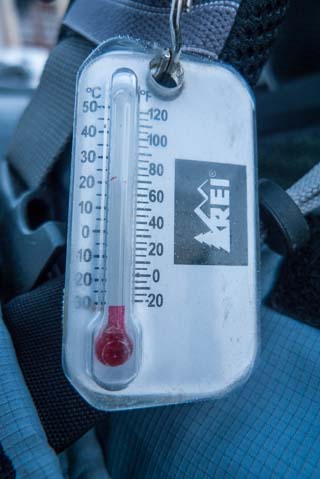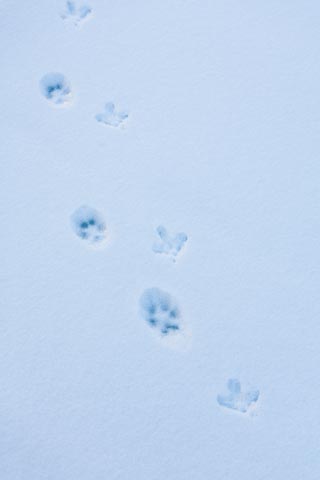Chadar gear discussion
The crux of knowing what to take is knowing what to expect. Please discuss with us anything you are not sure about.
In Delhi
In January and February in Delhi the days are pleasant enough, sometimes warm and sunny, sometimes chilly, grey and foggy. Long pants and shirt with a sweater or light jacket cover it.
If just transiting through the airport, the nights are chilly and you need a warm jacket.
In Leh
The temperature in the daytime maximum hovers around zero centigrade/32F, depending on how clear the sky is. Around town down jackets with a hood are essential, along with gloves and hat and thicker pants. Visiting the monasteries it is necessary to take your shoes off ... thick socks that you don't mind getting dirty are vital!
While trekking
On our Chadar treks we have seen the whole range of Ladakh winter conditions. You must plan for the worst so getting wet feet, and dealing with that in sub zero conditions and cover yourself for extreme conditions such as -25C with a breeze, as well as more pleasant conditions. Normally we found that we would start the day in down jacket, wind pants or soft shell pants, fleece hat and heavier gloves. By mid morning, both through exercise and sun, we would be in shell jacket with light layers under it, and sun hat. At the campsite we would quickly change in to the down jacket, insulated pants and down booties.
Who carries what
You carry a day pack with your camera, jacket, down jacket, water and snacks. The porters carry everything else. You need a large duffel (kit bag without wheels) and they are available in Leh, although it is better to bring from home.
Note the 15kg/33lb kit bag weight guideline for the trek (this doesn't include your daypack).
The Chadar trek - what you are planning for
Basically you should plan with 5 specific climates/functions in mind:
+ warm weather in Delhi if stopping over
+ cool-cold weather around Leh
+ walking on ice and snow in sub zero temperatures
+ difficult conditions on tricky ice, wading in 6 inches/15cms of water on ice
+ rock scrambling
+ evenings that can go down to -25ºC/-13F (warmer in your tent!)
Obviously, much of your gear will fulfill multiple roles.
Chadar gear discussion
Sleeping bag
A down-filled 4 or 5 season bag with a DryLoft or similar outer is better. The nights will be down to -12ºC to -20ºC in your tent, so your bag must be comfortable down to minus 25ºC/-13F or colder. We can provide a suitable sleeping bag for you, or a warm outer bag to put over your own bag; ask.
Sleeping bag liner
Silk or fleece or another thermo material. Saves washing your sleeping bag and adds warmth.
Inflatable sleeping pad
Thermarest or similar. We provide a closed cell foam mat for under your thermarest.
Large daypack
This should be comfortable and a good waist band that transfers some of the weight to the hips is most important. It needs to be big enough to take a jacket, down jacket, fleece, water, camera and odds and ends, so will probably be 40+ litres.
Boots
For on the ice: the best solution is boots that we buy in Leh, however the maximum readily available size is probably a UK11. In the past we have used high altitude mountaineering boots, great for when you break through a foot or more of ice, but not, even then, totally waterproof, and they are also heavy. But warm!
Fleece/Primaloft jacket
Essential, adds versatility. A thick thermal top is an alternative. With a hood is even better.
Down jacket
Essential. You need a real hooded parka, big and long and substantial, not a lightweight 'sweater'. We have some available but need your sizing.
Wind/rain jacket
Waterproof and breathable shell. Plastic ponchos or non-breathable raincoats are not suitable.
Thermal underwear top and bottom
Expedition weight, so think and warm, and might not come off for much of the trip.
Nightwear thermal top
Mid-weight or expedition-weight, and this is your second top in case the first gets wet.
Insulated pants
Synthetic (not down) and essential for the evenings; Patagonia, Mountain Hardwear, The North Face and all the US outdoor brands make them.
Day wear tops
Different layering combinations work for different people. Jamie uses a capilene mid-weight long sleeve top, a zip tee in 100 weight fleece, and an insulated soft shell. Joel used to use a hard shell, and added add another fleece layer, and for our lunch stop, a big down jacket.
Daywear bottoms
The best is some sort of soft shell pant, a good combo of partly waterproof and windproof, and warm and flexible, with thermals beneath. In addition to these you need a light windproof/waterproof shell, ie what the Brits call breathable rain pants.
Underwear
4 to 7 pairs; at least one set of merino wool underpants (and wool sports bra) would be nice.
Warm hat or balaclava
A good fleece hat, preferably windproof. Also a balaclava and a neck gaiter/buff (preferably the winter ones that also have fleece).
Gloves
Bring at least three pairs, light gloves, windstopper fleece gloves and either a shell to go over those or better, a separate pair of insulated gloves or mittens (if you already have). You really do need a variety.
Trekking poles
Essential, we recommend Black Diamond; avoid cheap Chinese-made models.
Sunglasses
Essential, with side pieces or wrap around. You need sun glasses for bright sun on snow, and you could bring a second lighter pair for a flatter light glare.
Water bottle
Should be one liter or more in capacity, take boiling water and be leak-proof. You need two liters total, and if you have an insulated cover, even better. Camelbaks and other drinking systems, even with insulated tubes, are no good. You must have bottles.
Pee bottle
This is used while you are in your tent. For the ladies, look into the Whiz, Freshette or similar to use for your pee bottle. The best pee bottle we have found is the Nalgene wide mouth rollup version (big and stows easily).
LED head torch
Essential, and ideal for reading in the tent and night toilet trips, bring an extra set of batteries. Black Diamond torches tend to be better than Petzl.
Toiletries and odds and ends
Essentials for the month only. The smallest tube of toothpaste is perfect for a month. We provide toilet paper, for the toilet; not for cosmetic or nose blowing! Please bring your own tissues. Nasal gel is nice to bring for sore noses (sold in most drug stores). Roll-on deodorant can spare you grief with your tent partner.
Towel
Bring only a small one trekking, or better, a face cloth.
Sun screen and lip care with sun protection
Essential. The sun is very strong at altitude. Absolutely the best lip balm is Banana Boat's sports, Aloe Vera or Vitamin E.
Moisturizer
A small tube for sensitive or well cared for skins. The air is dry and the sun harsh.
Sunhat
Essential, we hope!
First aid kit
We carry a comprehensive kit including acclimatization drugs. You must bring any personal medicines that you need.
Camera
Bring three sets of batteries, preferably original batteries rather than copies. We will discuss techniques on the ice.
Video camera
Ask. While trekking there is nowhere to recharge batteries.
Novel
Bring one or two with high swap ability.
Money pouch/belt/inside pocket
Most people find wearing one while trekking a hassle and keep it buried in their daypack.
Down booties
One of the ultimate luxuries that isn't a luxury, but a necessity on this expedition. Shoes and boots are not allowed in the dining tent.
Crampons-ice axe
Not needed. We will discuss grip options for the ice privately.
Evening camp wear
Around camp you can wear
+ a down jacket, thick and warm
+ insulated pants
+ warm hat, gloves
+ thick socks
Snacks and nutrition
You will feel your best with plenty of good food and keeping hydrated. We provide the food and the water, but the last two ingredients are wholesome snacks and vitamin tablets. Chocolate and chocolate bars are readily available in Leh but Clif bars, Power bars and the like are not available. Bring multi-vitamins from home.
What is available in Leh
Very little, so bring everything apart from chocolate bars from home.
What we provide
Our camping trips are full-service, we provide tents, sleeping pads, dining tent, cook tent, all supplies and food, porters and our fantastic staff and guides. You just need to bring your personal gear and a happy spirit!




